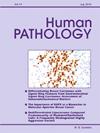结节外边缘区淋巴瘤:以诊断陷阱和与反应性疾病的鉴别诊断为重点的综述。
IF 2.7
2区 医学
Q2 PATHOLOGY
引用次数: 0
摘要
粘膜相关淋巴组织边缘区淋巴瘤(MALT淋巴瘤)占所有B细胞淋巴瘤的8%,是结外部位最常见的小B细胞淋巴瘤。确诊 MALT 淋巴瘤的金标准检测方法仍然是借助免疫组化(IHC)和/或流式细胞术免疫表型分析进行组织病理学分析。MALT 淋巴瘤是由持续性慢性炎症过程发展而来的,因此在某些病例中,通过组织病理学将 MALT 淋巴瘤与慢性炎症区分开来可能具有挑战性。尽管最近的趋势是将 IGH 重排/克隆作为 MALT 淋巴瘤的确诊检测方法,但这种方法远非理想,因为阳性或阴性结果并不一定能确定或排除某一过程是淋巴瘤还是反应性淋巴瘤。该检测必须与形态学结果相关联。此外,MALT 淋巴瘤可能与潜在的自身免疫性疾病有关,而在自身免疫性疾病中发现克隆淋巴细胞群的情况并不少见。因此,我们认为,在大多数病例中,最好采用综合方法(包括详细的形态学检查,结合 IHC 和/或流式细胞术)来确定 MALT 淋巴瘤的诊断。我们介绍了一些有用的形态学提示,以避免在一些最常见的结外部位(包括胃、眼附件/结膜、唾液腺、肺、胸腺、乳腺、甲状腺、小肠、大肠和硬脑膜)出现潜在的诊断误区。此外,还讨论了 MALT 淋巴瘤与 IgG4 相关疾病的鉴别诊断。本文章由计算机程序翻译,如有差异,请以英文原文为准。
Marginal zone lymphoma of extranodal sites: A review with an emphasis on diagnostic pitfalls and differential diagnosis with reactive conditions
Marginal zone lymphoma of the mucosa-associated lymphoid tissue (MALT lymphoma) represents 8% of all B-cell lymphomas and it is the most common small B-cell lymphoma arising at extranodal sites. The gold-standard test to establish a diagnosis of MALT lymphoma remains histopathologic analysis with the aid of immunohistochemistry (IHC) and/or flow cytometry immunophenotypic analysis. MALT lymphoma represents a progression from a persistent chronic inflammatory process, and therefore distinguishing MALT lymphoma from chronic inflammation by histopathology may be challenging in some cases. Despite recent trends to consider IGH rearrangement/clonality as a confirmatory diagnostic test of MALT lymphoma, this method is far from ideal for this purpose since a positive or a negative result does not necessarily confirm or exclude that a process is lymphoma or reactive. This test must be correlated with the morphologic findings. Moreover, MALT lymphoma may arise in association with underlying autoimmune conditions where clonal lymphoid populations are not uncommonly detected. Therefore, we believe that an integrated approach including detailed morphologic review in combination with IHC and/or flow cytometry is best to establish a diagnosis of MALT lymphoma in most cases. We present helpful morphologic tips to avoid potential diagnostic pitfalls at some of the most common extranodal sites, including the stomach, ocular adnexa/conjunctiva, salivary gland, lung, thymus, breast, thyroid, small and large intestine and the dura. The differential diagnosis of MALT lymphoma with IgG4-related disease is also discussed.
求助全文
通过发布文献求助,成功后即可免费获取论文全文。
去求助
来源期刊

Human pathology
医学-病理学
CiteScore
5.30
自引率
6.10%
发文量
206
审稿时长
21 days
期刊介绍:
Human Pathology is designed to bring information of clinicopathologic significance to human disease to the laboratory and clinical physician. It presents information drawn from morphologic and clinical laboratory studies with direct relevance to the understanding of human diseases. Papers published concern morphologic and clinicopathologic observations, reviews of diseases, analyses of problems in pathology, significant collections of case material and advances in concepts or techniques of value in the analysis and diagnosis of disease. Theoretical and experimental pathology and molecular biology pertinent to human disease are included. This critical journal is well illustrated with exceptional reproductions of photomicrographs and microscopic anatomy.
 求助内容:
求助内容: 应助结果提醒方式:
应助结果提醒方式:


